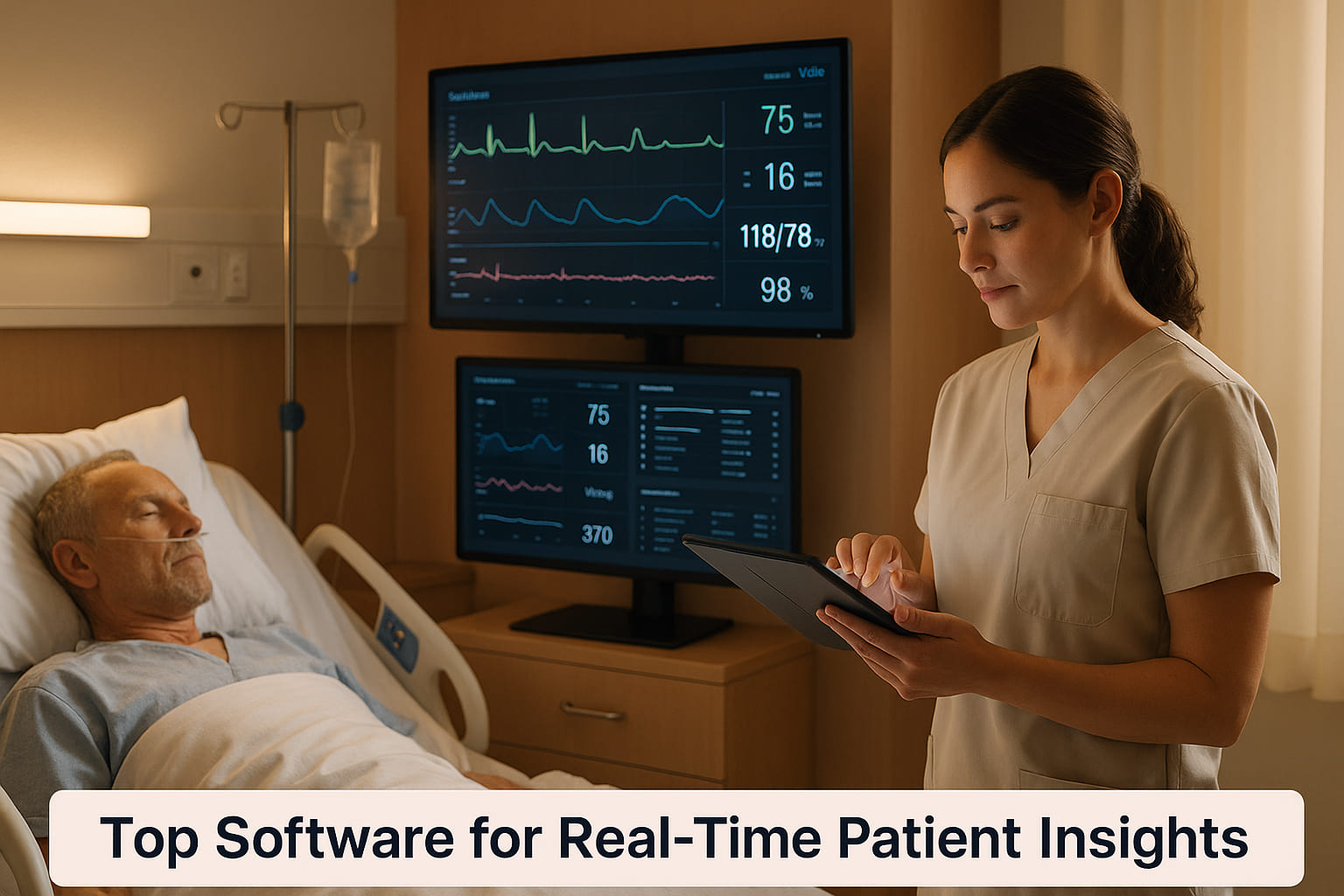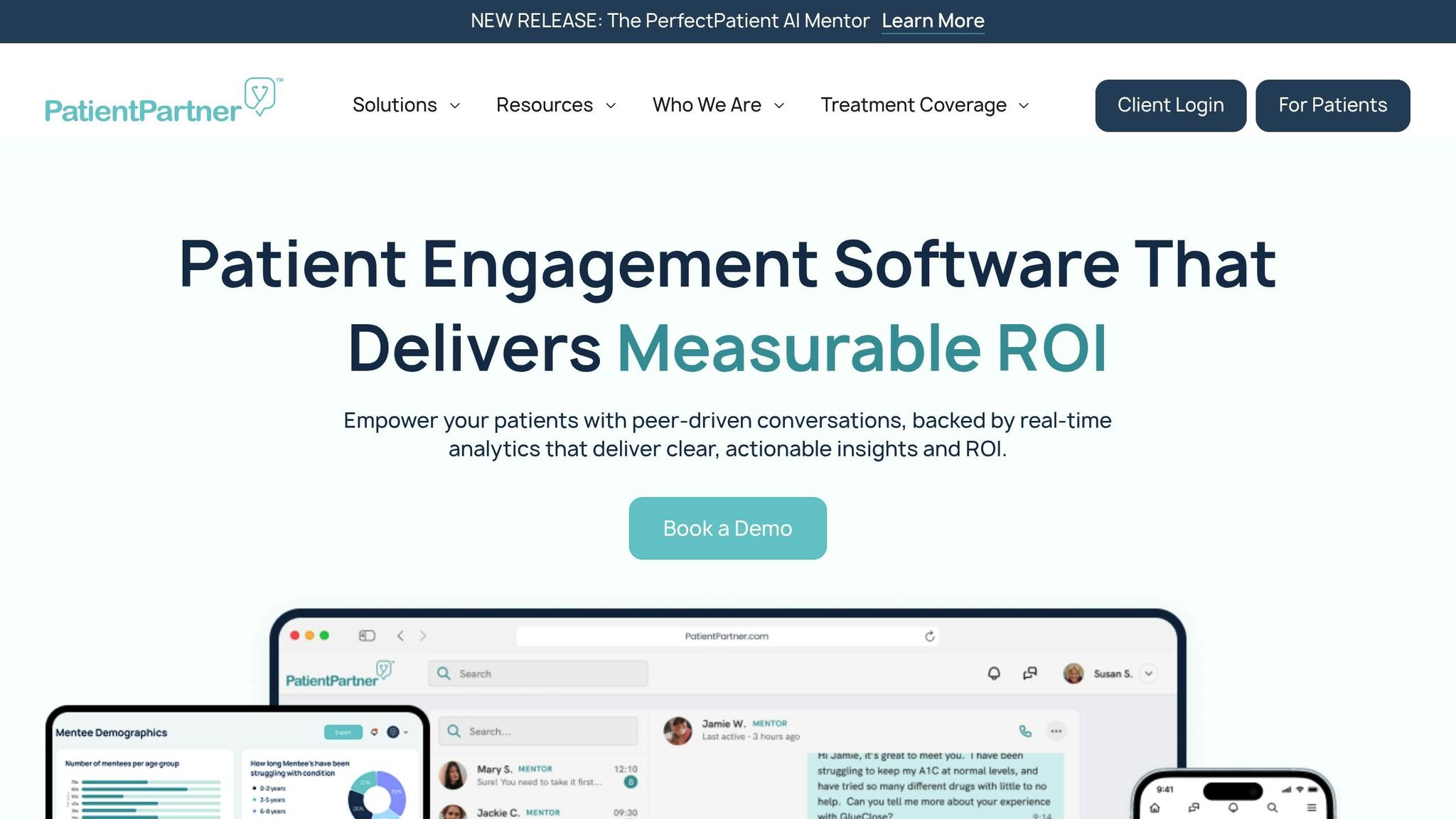Top Software for Real-Time Patient Data Insights


Key Takeaways
Top Software for Real-Time Patient Data Insights
Real-time patient data software helps healthcare organizations make faster, data-driven decisions to improve patient outcomes, streamline operations, and meet compliance standards. By instantly analyzing data from sources like wearables, patient portals, and EHRs, these platforms enable proactive interventions, personalized care, and better resource allocation.
Key Features to Look For:
- Real-Time Data Analysis: Immediate updates and predictive analytics to identify risks and trends.
- System Integration: Seamless connection with EHRs and other tools via APIs.
- Data Security and Compliance: HIPAA compliance, encryption, and audit trails to protect sensitive data.
Example Solution: PatientPartner combines patient mentorship with real-time analytics, improving adherence and treatment outcomes while maintaining strict compliance. Its AI-driven insights help healthcare leaders optimize patient engagement and program effectiveness.
Why It Matters:
- Improved Outcomes: Early risk detection enables timely interventions.
- Efficiency Gains: Automates routine tasks and reduces manual errors.
- Regulatory Readiness: Simplifies compliance with audit-ready systems.
Choosing the right platform ensures better care delivery, operational efficiency, and secure data management.
Improving Hospital Operations with Streaming Data and Real Time AI/ML
How to Choose Real-Time Patient Data Software
Choosing software for real-time patient data requires careful consideration of its features, security measures, and ability to integrate with existing systems. The right platform can significantly impact response times, compliance, and patient outcomes. Here's what to look for when evaluating your options.
Real-Time Data Collection and Analysis
A reliable platform should capture and process patient data in real time, delivering updates within seconds or minutes of interactions. This ensures that healthcare providers can act quickly and effectively.
The software must support multiple data sources simultaneously, including patient portals, mobile apps, wearable devices, and direct communications. It should not only gather this information but also analyze it immediately to identify patterns, flag potential issues, and prompt timely responses.
Advanced analytics are essential. Look for platforms that use tools like machine learning to go beyond basic data collection. For example, predictive algorithms can identify patients at risk of non-adherence or those who might develop complications, enabling proactive intervention.
Equally important is how the software presents this information. Role-specific dashboards can deliver tailored alerts and trend analyses, ensuring that each member of your team gets the insights they need. Additionally, the ability to maintain historical data alongside real-time updates allows for a deeper understanding of patient journeys and supports immediate decision-making in critical situations.
Healthcare System Integration
Integration with your existing systems is just as important as real-time data capabilities. The software should connect seamlessly with electronic health records (EHRs), practice management systems, and other tools your organization already uses.
APIs that support bidirectional data flow are key to keeping patient information consistent across platforms. This eliminates the need for manual data entry and reduces the risk of errors. Some solutions offer plug-and-play functionality with pre-built connectors, while others may require more technical resources for custom integration. Be sure to assess your organization's IT capabilities and budget when making your decision.
Interoperability standards like HL7 FHIR are critical for smooth communication between systems, offering flexibility as your technology evolves. To minimize disruptions during implementation, choose a vendor that provides robust support, including data migration, staff training, and ongoing technical assistance. The complexity of your systems and the vendor’s approach will influence how long the process takes.
Data Security and Compliance
Protecting sensitive patient data is non-negotiable. The software must meet HIPAA compliance standards and provide robust security features to safeguard information.
Key security measures include end-to-end encryption for data in transit and at rest, role-based access controls, and detailed audit logs to track system activity. Vendors should also conduct regular security assessments and penetration testing to demonstrate their commitment to protecting your data.
Ask about certifications like SOC 2 compliance and any healthcare-specific security frameworks the vendor adheres to. If your organization operates across multiple states or internationally, it's vital to understand where patient data is stored and processed to ensure compliance with local regulations.
Finally, ensure the vendor offers a business associate agreement (BAA) to clarify their responsibilities when handling protected health information. This agreement, along with liability insurance, provides an added layer of assurance in case of data breaches or security incidents.
PatientPartner: Real-Time Patient Mentorship and Data Analytics

PatientPartner is a B2B SaaS platform designed to blend patient mentorship with real-time analytics, catering to pharmaceutical and med-tech companies. By connecting patients with seasoned mentors, the platform provides guidance throughout the healthcare journey - from starting treatment to staying on track long-term. This combination of mentorship and data insights creates a more personalized approach to patient engagement.
Patient Mentorship and Engagement
The heart of PatientPartner lies in its mentor matching system, which pairs patients with mentors who have firsthand experience managing similar health challenges. This personalized pairing helps patients overcome initial barriers and receive tailored support during treatment. The platform also runs ambassador programs, where individuals who have successfully navigated their own healthcare journeys offer peer-to-peer support. These connections are designed to feel genuine and relatable, building trust and improving engagement. Additionally, PatientPartner uses analytics to fine-tune these interactions, ensuring patients receive the right level of support.
Patient Sentiment and Adherence Analytics
PatientPartner doesn’t stop at mentorship - it also tracks patient sentiment and adherence patterns. By analyzing this data, the platform provides healthcare leaders with actionable insights to improve their support strategies. This approach helps organizations better understand patient needs while also measuring the effectiveness of their programs, ultimately aiming to enhance treatment outcomes.
Compliance and Scalability Features
Built with compliance in mind, PatientPartner adheres to regulatory standards while offering the flexibility to scale across various therapeutic areas. The platform ensures that patient data is handled securely and in real-time, creating a privacy-conscious environment that aligns with modern patient care needs.
sbb-itb-8f61039
Current Trends in Real-Time Patient Analytics
Real-time patient analytics is evolving rapidly, driven by advancements in technology, shifts in regulatory landscapes, and the growing need for seamless data integration. These changes are reshaping how healthcare organizations gather, analyze, and act on patient data. Let’s explore how artificial intelligence (AI), unified systems, and compliance innovations are transforming this field.
AI and Machine Learning Features
AI and machine learning are no longer just buzzwords - they’re becoming central tools in real-time patient analytics. These technologies empower healthcare providers to go beyond simply collecting data, offering predictive insights that anticipate patient needs and behaviors.
For example, modern AI tools can detect patterns in patient engagement that would be impossible to spot manually. Techniques like predictive modeling and natural language processing (NLP) are especially impactful. NLP can analyze patient feedback, survey responses, and communication logs to gauge sentiment, helping healthcare leaders pinpoint areas where patient satisfaction can improve.
Predictive modeling takes it a step further by merging data from various sources - such as demographics, treatment records, and engagement metrics - to create detailed risk profiles. This allows pharmaceutical companies and med-tech firms to allocate resources more strategically and tailor their patient support programs.
System Interoperability and Unified Platforms
The era of isolated, standalone systems in healthcare is fading fast. Organizations now prioritize interoperable solutions that integrate seamlessly with existing infrastructures, creating unified data ecosystems.
Cloud-based platforms are leading the charge by standardizing data synchronization across systems. This ensures patient information flows smoothly, eliminating the silos that often hinder effective care.
Unified platforms also provide healthcare professionals with a complete view of the patient journey. From initial contact to long-term treatment adherence, having all touchpoints in a single dashboard enables better decision-making and more coordinated care. This holistic approach is becoming the gold standard for patient support strategies.
Compliance Standards and Regulations
As healthcare systems become more interconnected, ensuring data privacy and security is more critical than ever. Compliance requirements are shaping how real-time analytics platforms are designed and deployed. In the U.S., HIPAA compliance remains a cornerstone, but organizations are also preparing for new privacy regulations that could emerge in other regions.
One growing trend is the use of region-specific cloud deployments, which ensure patient data stays within designated geographic areas. Built-in compliance monitoring tools are also becoming standard, helping organizations maintain privacy standards without adding administrative burden.
Compliance isn’t just a legal necessity - it’s becoming a competitive edge. Companies that can demonstrate strong compliance frameworks are more likely to secure enterprise contracts and build trust with partners. Features like audit-ready systems are particularly appealing. These platforms automatically generate compliance reports and maintain detailed logs of data access and processing, making it easier for organizations to respond to audits or regulatory inquiries with confidence.
Conclusion
Choosing the right software for real-time patient data insights has become a top priority for healthcare executives navigating today’s fast-paced healthcare landscape. Tools that combine AI-driven analytics, seamless system integration, and strong compliance measures set the stage for impactful patient engagement and measurable results.
PatientPartner is a standout example of this approach. By connecting patients with mentors who have firsthand experience, this platform offers personalized, real-time interactions supported by AI. The result? Scalable, results-driven engagement.
The PerfectPatient AI Mentor reports impressive metrics: a 95% engagement rate, an average session time of over 14 minutes, and performance that far surpasses traditional chatbots. With 3x higher engagement, a 52% increase in adherence, treatment initiation 35% faster, and a 40% reduction in drop-off rates, it’s clear this approach delivers results.
These outcomes translate into tangible business advantages. PatientPartner clients have seen a 30% rise in treatment adoption and a 20% boost in adherence within the first year. Patients who engage with mentors are 68% more likely to start their prescribed treatment and, on average, stay on treatment 133.5 days longer. For pharmaceutical and med-tech companies aiming to improve patient starts and adherence, these metrics highlight significant gains in program performance. Additionally, PatientPartner’s compliance infrastructure ensures secure and regulation-ready implementation.
FAQs
How can real-time patient data software enhance healthcare outcomes and efficiency?
Real-time patient data software is reshaping healthcare by offering immediate insights that help identify health concerns early, tailor treatment plans to individual needs, and encourage consistent medication adherence. These capabilities directly enhance patient care, allowing healthcare providers to make decisions quickly and with greater precision.
Beyond improving patient outcomes, this technology also enhances the overall efficiency of healthcare systems. It simplifies communication between patients and providers, reduces unnecessary delays, and supports proactive care management. The result? Streamlined operations, lower costs, and happier patients - a clear benefit for everyone involved.
What security features should a real-time patient data platform have to comply with HIPAA regulations?
To meet HIPAA requirements, a real-time patient data platform must prioritize data encryption - both while the data is being transmitted and when it is stored. Implementing multi-factor authentication and strict access controls is equally important to ensure that only authorized individuals can access sensitive patient information. Additional safeguards, such as audit trails and secure data storage, play a key role in tracking access and preserving data integrity.
Conducting regular risk assessments and following the administrative, physical, and technical safeguards outlined in the HIPAA Security Rule are non-negotiable. These steps are essential not only for protecting patient data but also for maintaining confidentiality and reinforcing trust in the platform.
How do AI and machine learning improve real-time patient data analytics in healthcare?
AI and machine learning are transforming real-time patient data analytics by processing enormous volumes of healthcare data with incredible speed and precision. These tools can uncover intricate patterns, predict potential health risks, and aid in the early detection of medical issues. The result? Faster, more accurate decision-making that can make a real difference in patient care.
With AI-driven insights, healthcare providers can create personalized treatment plans tailored to individual needs, leading to better patient outcomes. At the same time, these technologies help improve operational workflows, making care delivery more efficient. By simplifying processes and supporting long-term patient engagement, AI not only enhances treatment adherence but also brings measurable benefits to both patients and healthcare organizations.
Author

Co-Founder and CEO of PatientPartner, a health technology platform that is creating a new type of patient experience for those going through surgery







